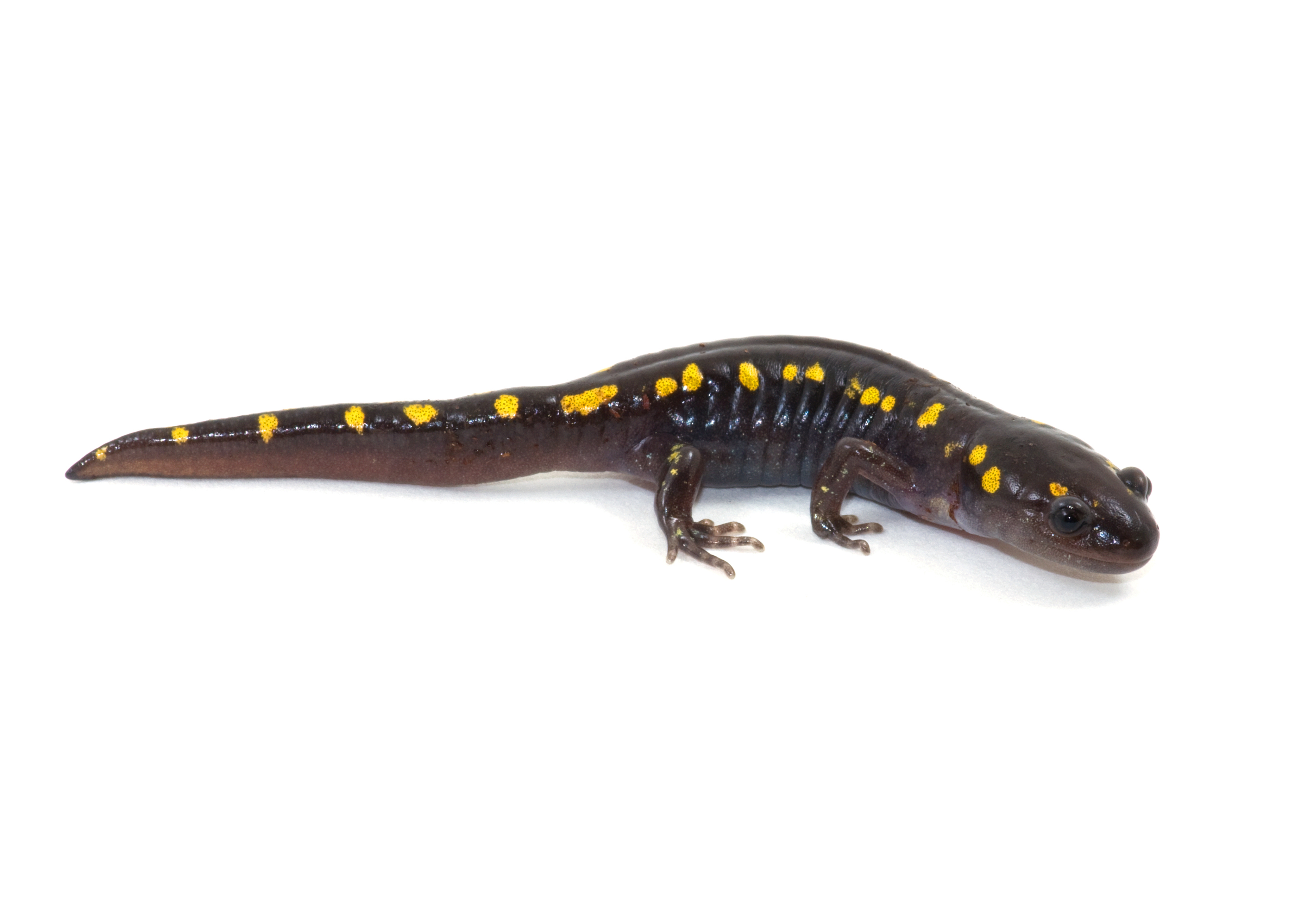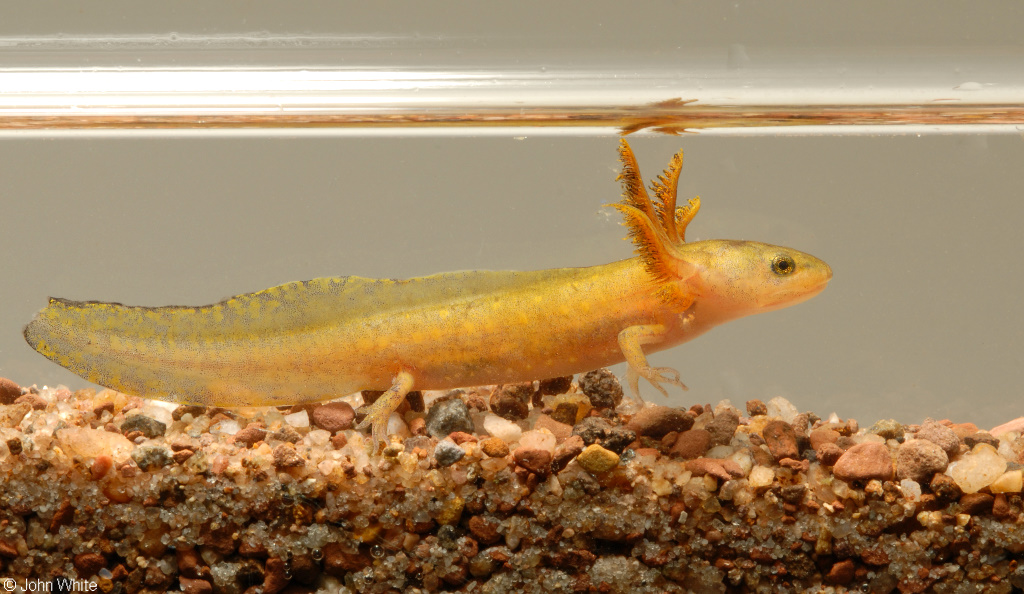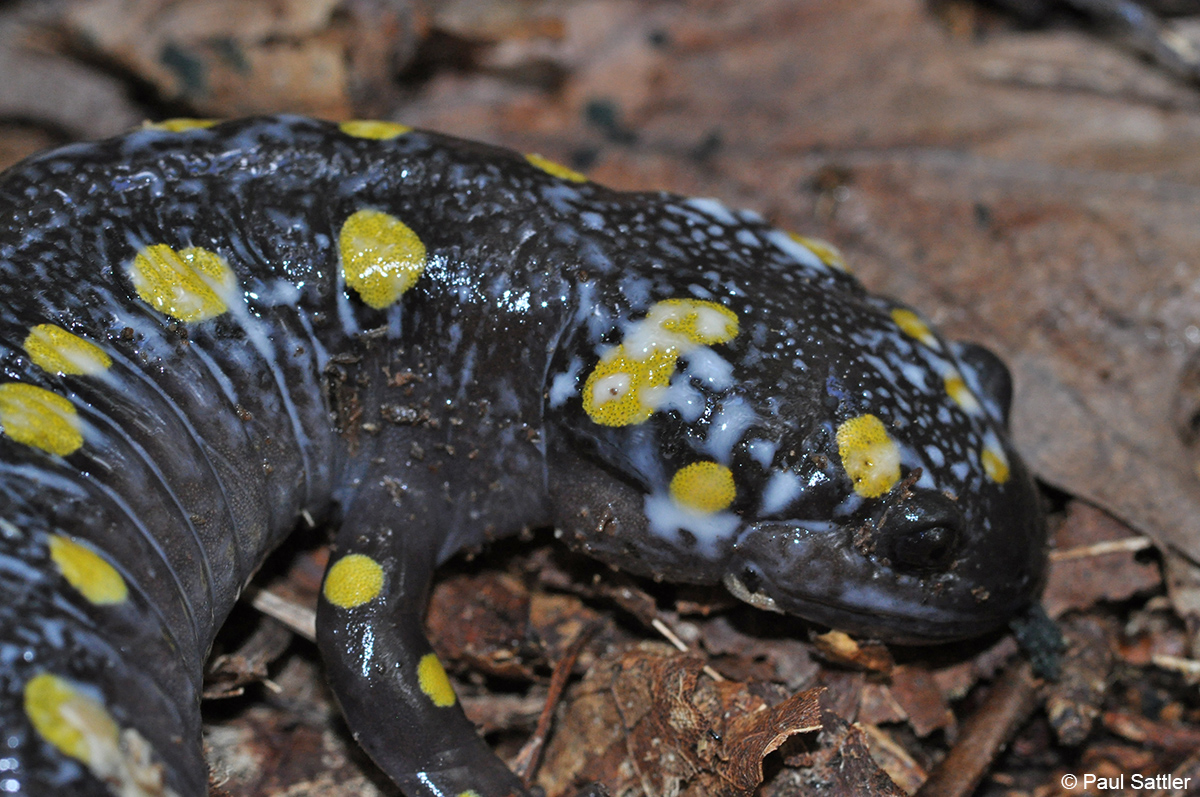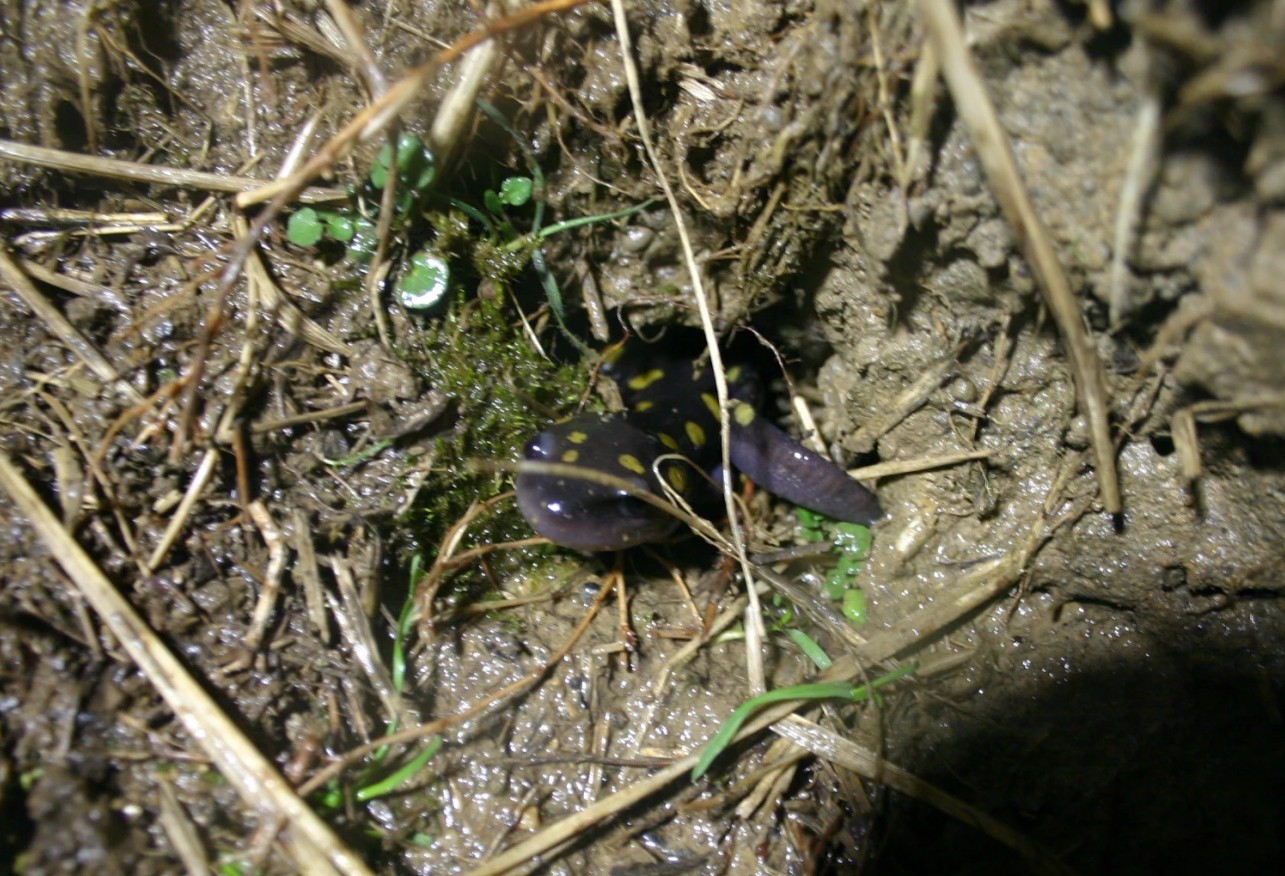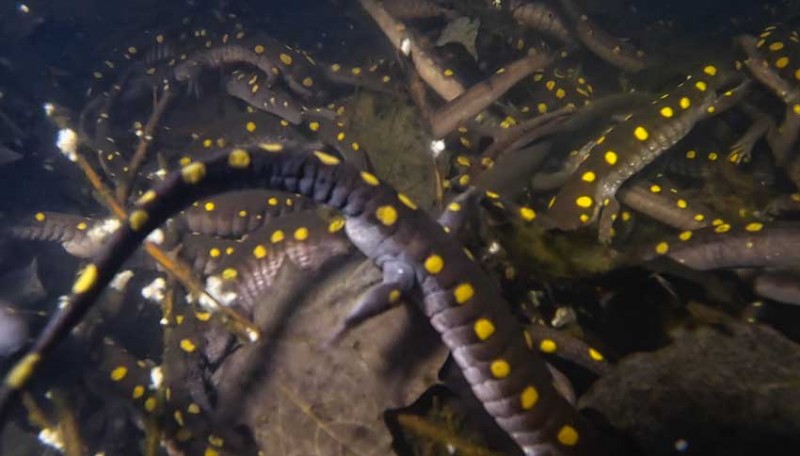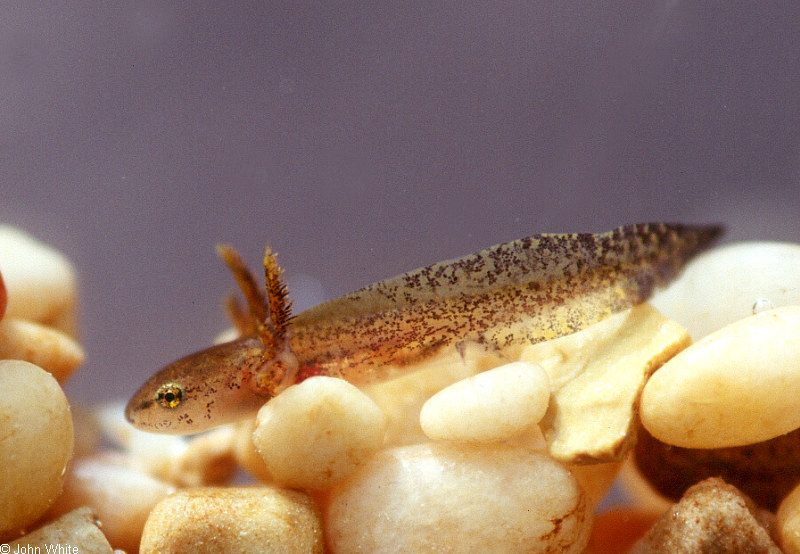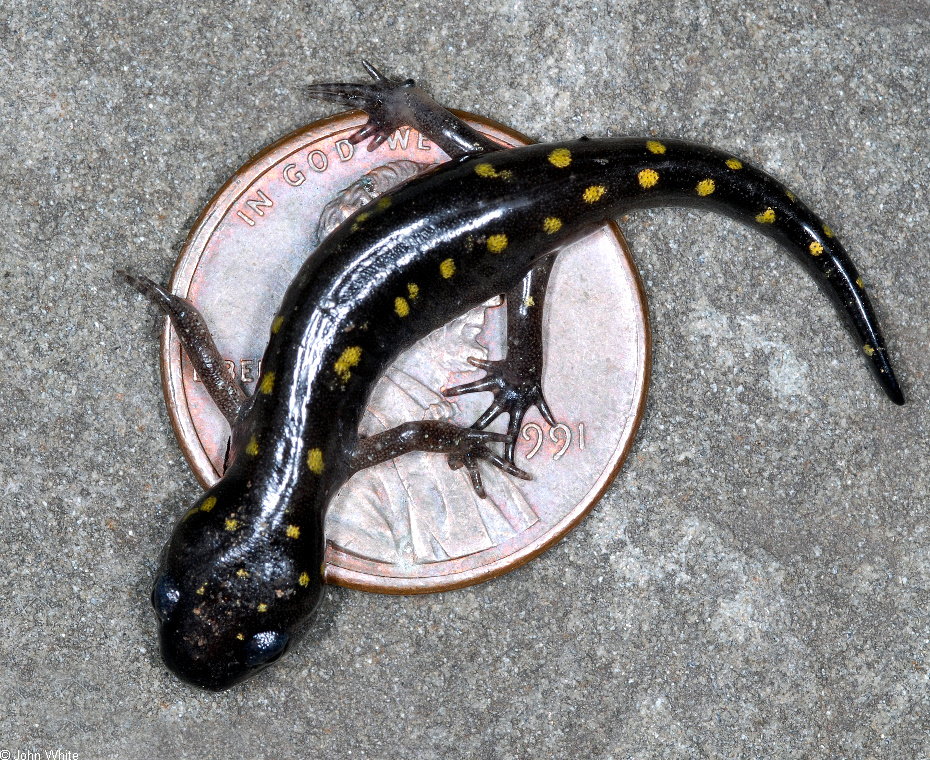Wonders of Wildlife: Spotted Salamander
Spotted Salamander
Other Common Names: Yellow-spotted salamander
Scientific Name: Ambystoma maculatum
Found in Alabama: Common statewide except in a few counties in southern Alabama. Population may be declining.
Diet: Carnivore (eats animals) |
|
Spotted Salamander
Dreamstime
Click image to enlarge it |
Learn more about...
| CLASSIFICATION |
|
What type of animal am I?
- I am a vertebrate (an animal with a spine or backbone).
- I am cold-blooded, so I cannot control my body temperature.
- I do not have scales, feathers, or fur, so I have smooth skin.
- I breathe through my skin.
- I have 4 legs.
|
Scientists use basic traits to group animals into different taxonomic classes.
For a taxonomic classification chart comparing key traits of common backyard wildlife,
CLICK HERE! |
|
| The Spotted Salamander is an AMPHIBIAN! |
| IDENTIFICATION TIPS |
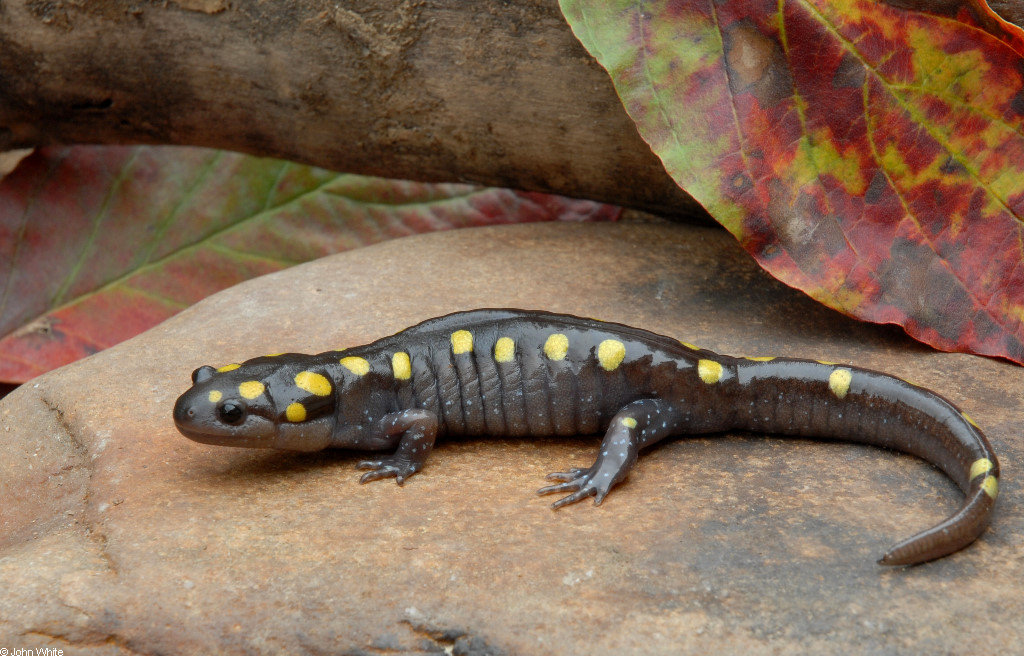
Spotted Salamander
Virginia Herpetological Society
Click image to enlarge it |
ADULT SPOTTED SALAMANDER |
- Range from 6-9.5 inches in length from head to tail
- Black, brown or gray with two rows of yellow or orange spots along their back
- Males and females look alike
- Females tend to be slightly larger than male
|
| JUVENILE SPOTTED SALAMANDER |
Spotted Salamander larva
Virginia Herpetological Society
Click image to enlarge it |
- Larvae (newly hatched young) are lighter in color and have external gills that look like feathery antlers
- Juveniles who have gone through metamorphosis (physical changes) look similar to adult, but smaller.
|
| ADAPTATIONS |
| |
| PHYSICAL ADAPTATIONS |
| |
| Spotted salamanders defend themselves using poison: |
- When threatened, spotted salamaders produce a poisonous fluid from a gland in their head and tail.
- This substance tastes bad to predators (animals that eat them) and can cause a burning feeling in the predator's mouth.
|
Spotted salamander oozing poison
Virginia Herpetological Society - Paul Sattler
Click image to enlarge it |
| |
| Spotted salamanders can regenerate (regrow) body parts: |
- If a spotted salamander is injured and loses limbs or some organs, it is capable of regenerating (regrowing or growing new) them.
- Unlike some salamanders that can drop their tails on purpose when threatened, spotted salamanders regenerate after injury.
- Spotted salamanders and closely related species, such as Mexican Axolotls (Ambystoma mexicana), are capable of regrowing limbs, finger, toes, eyes, hearts, spinal cords, and even up to a quarter of their brain!
- When a spotted salamander loses a limb, their bodies know where on the limb the amputation occurred, and they are able to regrow a new limb from that place with all of the necessary parts, including bone, muscle, veins, and nerves. The limb will eventually grow to its original size.
|
| |
| BEHAVIORAL ADAPTATIONS |
| |
| Spotted salamanders are nocturnal: |
- They are nocturnal (active during the night) which helps them avoid predators (animals that eat them).
|
| |
| Spotted salamanders use burrows: |
- Spotted salamanders are fossorial, meaning that they spend most of their life underground in their burrows.
- They are rarely seen except during breeding season.
- During warm, dry days, spotted salamanders use burrows or root tunnels to stay cool and damp.
- If a threat is spotted, they use the tunnel as an escape.
- In the winter, spotted salamanders use these burrows to enter a state of hibernation (becoming dormant as if they are in a deep sleep). They emerge and become active in the spring when temperatures become warmer.
|
Spotted Salamander emerging from burrow
Chris Welter
Click image to enlarge it |
| |
| Slimy salamanders are Predators: |
- Spotted salamanders are sit-and-wait predators that wait for prey (animals that they eat) to come near them rather than hunting.
- At night when it is cooler, they sit at the entrance of the burrow, waiting to ambush prey.
- When prey comes close, the salamander will use its sticky tongue to caoture the prey and bring it to them.
|
| |
|
| Spotted Salamanders have Spring Migrations: |
- As the weather starts to get warmer in spring, spotted salamanders leave the burrows that they spend most of the year in so that they can reproduce.
- Spotted salamanders will travel up to a mile, risking predation and being run over by cars, to reach the exact same vernal ponds (shallow temporary ponds that occur after heavy spring rains) year after year.
- When the first spring rains happen, all of the males leave their burrows at night to return to the vernal ponds where they were born.
- The next night, all the females leave their burrows as well to go join the males.
- Males court females by nudging their heads together, and they pick a spot where the female lays her eggs.
- After the eggs are laid, the adult salamanders leave the pond and return to their burrows until next spring.
|
Spotted Salamanders in vernal pond
Lang Elliot
Click image to enlarge it |
The Friends of Shade Creek group near Birmingham, AL has a wonderful annual Salamander Festival at which they celebrate the spotted salamander and its migration. For more info, check out their website.
|
| |
| LIFE CYCLE |
| |
|
|
| Egg: |
- Spotted salamander females lay up to 1,000 eggs in 2-4 masses each breeding season in shallow, temporary ponds or wetlands.
- These eggs are coated in a thick, jelly-like substance to protect the eggs from drying out and to protect them from predators.
- Spotted salamanders lay their eggs near algae that helps the eggs breathe while they are coated with the jelly. This is called a symbiotic relationship (two different species that live together and interact).
- Females leave eggs after laying them and provide no parental care.
|
Spotted Salamander Egg Mass
Virginia Herpetological Society
Click image to enlarge it
|
| |
|
Larvae:
|
- Once the larvae (newly hatched young) emerge from eggs, they are independent and live in the waterway where they hatched.
- Larvae have 4 weak legs and use a large tail to swim.
- Larvae breathe using external gills which work like a fish's gills but look like feathery antlers on the side of their head.
- Spotted slamanders live as larvae for 6-12 weeks.
|
Spotted Salamamder larva
© John White
Click image to enlarge it |
| |
|
|
Juvenile:
|
- As a spotted salamander undergoes metamorphosis (physical changes) from larvae to adult, its legs grow and become stronger, and its tail changes shape.
- Juveniles lose their external gills and use lungs to breathe as they leave the pond they were born in.
- Juveniles look the same as adult spotted salamanders, but are much smaller.
- It takes juveniles about 5 years to mature and become adults.
|
Juvenile Spotted Salamamder size
compared to a penny
Virginia Herpetological Society
Click image to enlarge it |
| |
|
|
| Life Span: |
- Spotted salamanders can live up to 20 years.
|
NATURAL
Habitat Needs |
ADULTS |
YOUNG |
| Food |
- Will eat invertebrates (animals without a backbone) including earthworms, snails, spiders, and beetles.
|
- Will eat aquatic invertebrates (animals without a backbone) including zooplankton, copepods, and isopods.
|
| Water |
- Moisture is essential for keeping their bodies moist and hydrated.
- This is especially important because they breathe through their skin as adults and in water as larvae.
|
| Shelter |
- Live in moist forested areas, river bottomed hardwood forests, and near shallow waterways including ephemeral (temporary) ponds and wetlands.
- Can be found under rotting logs, rocks, rock crevices, and other debris.
|
- Live in shallow waterways, including ephemeral (temporary) ponds and wetlands.
|
| Places to Raise Young |
- Eggs are laid in shallow temporary pools or wetlands.
|
|
BACKYARD
Habitat Needs |
ADULTS |
YOUNG |
| Food |
- Avoid using fertilizers, pesticides, and herbicides which would negatively impact invertebrates (animals without a backbone), which is the food source for salamanders.
|
| Water |
- Provide a still or slow-moving water source such as a shallow pond.
- Do not remove moist, decaying logs or other natural debris.
|
| Shelter |
- Plant marginal aquatic plants in sources of water such as a shallow pond to help provide cover from predators.
- Do not remove rocks, rotting logs, or other natural debris that can also provide shelter.
|
| Places to Raise Young |
- Provide a still or slow-moving water source such as a shallow pond where females can lay egg masses.
|
|
| ECOLOGICAL ROLE |
| |
|
| Animals play an important ecological role in the health of habitats and ecosystems. |
| |
|
Food Source: |
- Snakes are the main predators (animals that eat them) of spotted salamanders.
- They may also provide a food source for birds and small mammals.
|
| Insect Population Control: |
- Spotted salamanders eat a lot of insects which helps limit the populations of pest insects, including mosquitoes.
|
Soil Dynamics: |
- The burrowing behavior of the slimy salamander may play a role in introducing air to the soil (aeration).
- This process can help move nutrients and water through the soil.
|
.
 Wildlife Tag
Wildlife Tag
